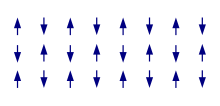
Back Antiferromagnetisme Afrikaans مغناطيسية حديدية مضادة Arabic Антиферомагнетизъм Bulgarian Antiferromagnetisme Catalan Antiferomagnetismus Czech Antiferromagnetismus German Αντισιδηρομαγνητισμός Greek Antiferomagnetismo Esperanto Antiferromagnetismo Spanish Antiferromagnetism Estonian
This article needs additional citations for verification. (May 2014) |

| Condensed matter physics |
|---|
 |
In materials that exhibit antiferromagnetism, the magnetic moments of atoms or molecules, usually related to the spins of electrons, align in a regular pattern with neighboring spins (on different sublattices) pointing in opposite directions. This is, like ferromagnetism and ferrimagnetism, a manifestation of ordered magnetism. The phenomenon of antiferromagnetism was first introduced by Lev Landau in 1933.[1]
Generally, antiferromagnetic order may exist at sufficiently low temperatures, but vanishes at and above the Néel temperature – named after Louis Néel, who had first in the West identified this type of magnetic ordering.[2] Above the Néel temperature, the material is typically paramagnetic.
- ^ Landau, L. D. (1933). A possible explanation of the field dependence of the susceptibility at low temperatures. Phys. Z. Sowjet, 4, 675.
- ^ M. Louis Néel (1948). "Propriétées magnétiques des ferrites; Férrimagnétisme et antiferromagnétisme" (PDF). Annales de Physique. 12 (3): 137–198. Bibcode:1948AnPh...12..137N. doi:10.1051/anphys/194812030137. S2CID 126111103.
© MMXXIII Rich X Search. We shall prevail. All rights reserved. Rich X Search